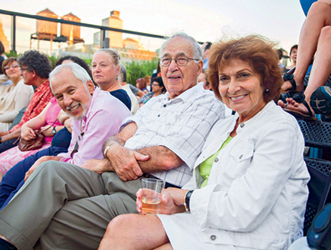Citrus and Balsamic–Glazed Turkey Breast

This recipe relieves you of any turkey timing and carving anxieties left over from Thanksgiving. It makes a delicious alternative to the standard Friday night roasted chicken dinner, plus it’s an easy way to serve a crowd. It uses a boneless turkey breast, which cooks much more quickly than a whole bird. It also slices beautifully and the leftovers are great in sandwiches.
SERVES 8 TO 10
1 (4-to-5-pound) boneless turkey breast, skin on and tied
3 tablespoons extra-virgin olive oil
1 teaspoon kosher salt, plus more for seasoning
½ teaspoon freshly gound black pepper, plus more for seasoning
1½ pounds cipollini onions or small shallots
1 Meyer lemon, clementine, or small orange, sliced thin and seeded
1 shallot, finely chopped (about 1 tablespoon)
¾ cup orange juice
¼ cup good-quality balsamic vinegar
3 tablespoons honey
4 sprigs fresh rosemary
½ teaspoon cornstarch, arrowroot, or potato starch
⅔ cup dry white wine
⅔ cup chicken stock
Position a rack in the center of the oven and preheat it to 500°F.
Rub the breast with 2 tablespoons of the olive oil and sprinkle with 1 teaspoon salt and ½ teaspoon pepper. Transfer the breast to a baking dish or roasting pan. Scatter the onions and lemon slices around the breast. Roast for 15 minutes. Reduce the heat to 325°F and continue to roast until the juices run clear and a meat thermometer inserted in the thickest part registers 160°F, about 1½ hours.
Meanwhile, make the glaze: In a medium saucepan, heat the remaining 1 tablespoon olive oil over medium heat. Add the shallot and sauté until softened, 2 to 3 minutes. Add the orange juice, balsamic vinegar, honey, and rosemary and bring to a boil. Reduce the heat and simmer until reduced by about half, about 10 minutes. Whisk in the cornstarch, stirring to avoid lumps. Remove from the heat and cool. During the last 30 minutes of cooking, brush the turkey with enough glaze to coat it.
When the turkey is done, transfer it to a board to rest. Scrape the drippings into the remaining glaze and add the wine and stock. Bring the mixture to a boil and cook until the liquid is reduced by half, about 5 minutes. Season with salt and pepper. Pour the liquid into a gravy separator or spoon off any fat that has collected on the top. Remove the strings, slice the turkey, and serve with the gravy.
Braised Duck Legs

This is the perfect make-ahead dinner for a cold winter night, when we crave rich meats cooked in wine. Here, the duck is braised with madeira and red wine, vegetables, and herbs, then crisped in a hot oven—delicious! Serve with Garlic Mashed Potatoes (here) or wide noodles.
4 large duck legs with thighs (8 to 10 ounces each), excess fat removed
½ tablespoon fresh thyme leaves, plus 6 (2-inch) sprigs
Kosher salt and freshly ground black pepper
2 tablespoons extra-virgin olive oil
1 large red onion, chopped (about 1 cup)
1 garlic clove, chopped (about 1 teaspoon)
2 medium carrots, peeled, diced (about 1 cup)
1 large celery stalk, diced (about ½ cup)
4 (2-inch) fresh thyme sprigs
1 bay leaf
3 fresh sage leaves
1 tablespoon tomato paste
1¾ cups madeira or marsala wine
¼ cup dry red wine
3 cups duck or chicken stock, plus more as needed
2 teaspoons chopped fresh flat-leaf parsley, for garnish
At least 1 hour or up to 3 hours in advance, sprinkle the duck with the thyme leaves. Season with salt and pepper. Set aside.
Heat a very large, deep heavy sauté pan or Dutch oven over high heat until very hot. Add the oil, swirl to coat the pan, and wait 1 minute to ensure that the oil is very hot as well. Then, working in batches if necessary, place the duck legs in the pan, skin side down. Don’t crowd the pan. Cook until the skin is just past golden, 8 to 12 minutes. Turn the legs, reduce the heat to medium, and cook just to sear, 2 minutes more. Transfer the legs, skin side up, to a plate and set aside.
Remove all but 1 tablespoon of the fat from the pan (save or discard the rest of the fat). Add the onion, garlic, carrots, celery, thyme sprigs, bay leaf, and sage leaves. Season with pepper and sauté until the vegetables have browned, about 10 minutes. Stir in the tomato paste and add the madeira and red wine. Increase the heat to high, bring the liquid to a boil, and cook until the liquid is reduced by half, 6 to 8 minutes. Add the stock, reduce the heat, and simmer until slightly reduced, about 10 minutes.
Preheat the oven to 350°F.
Gently place the duck legs skin side up on top of the vegetables and broth in the pan. Don’t crowd the pan and make sure no liquid or vegetables are on top of the duck. Cover the pan tightly with heavy-duty foil and a tight-fitting lid. Transfer to the oven and braise until the duck is very tender, but not yet falling off the bone, about 2 hours.
Increase the oven heat to 400°F. Carefully transfer the duck pieces, skin side up, to a baking sheet. Return to the oven and bake until the skin is crisp, 10 to 15 minutes. Meanwhile, spoon off as much fat as possible from the sauce (keep or discard), and cook over high heat until the sauce is further thickened and hot, about 5 minutes.
To serve, spoon the sauce with vegetables onto a warm platter, top with the crisped duck, and sprinkle with the parsley. Serve with the additional sauce passed separately.
